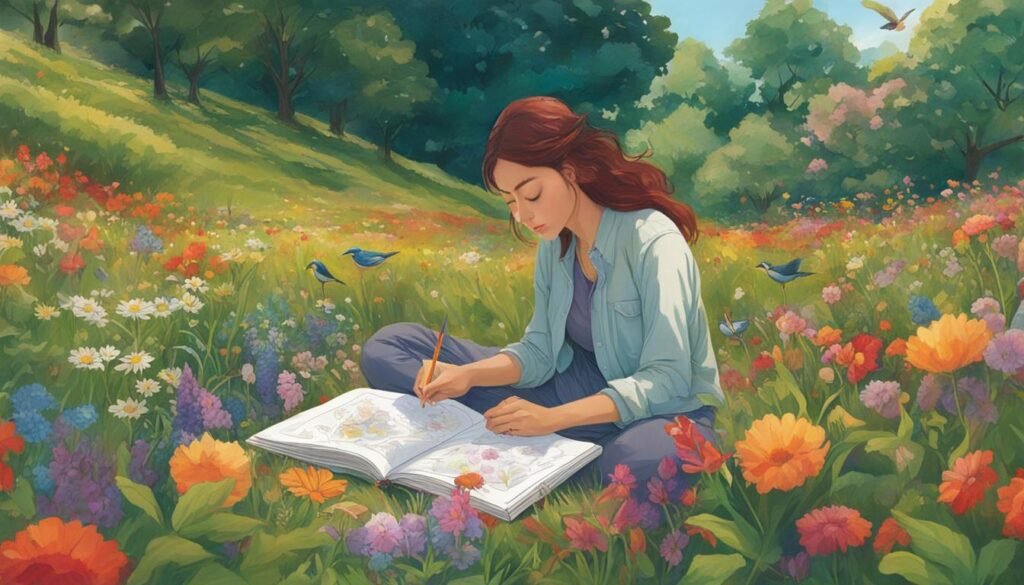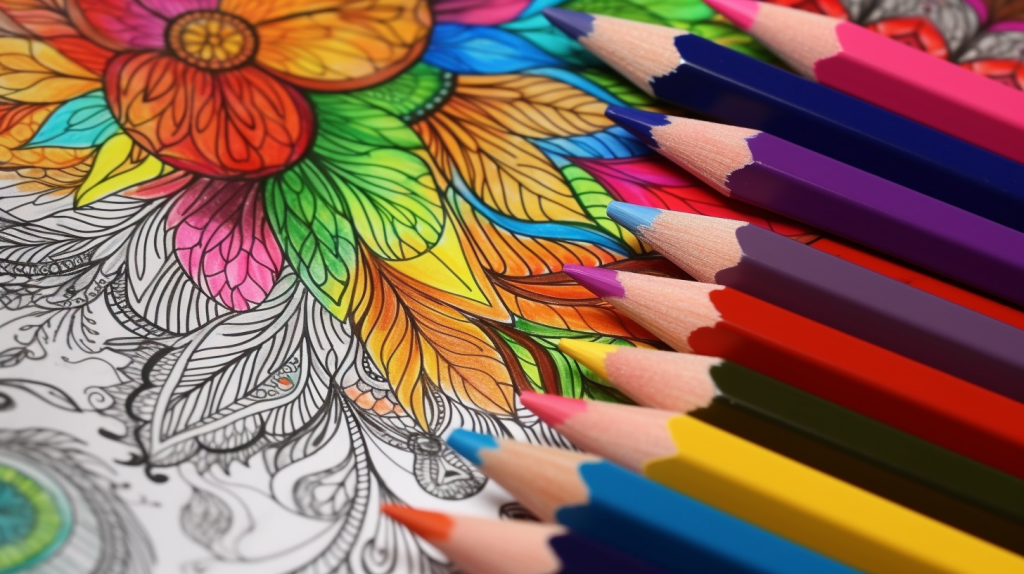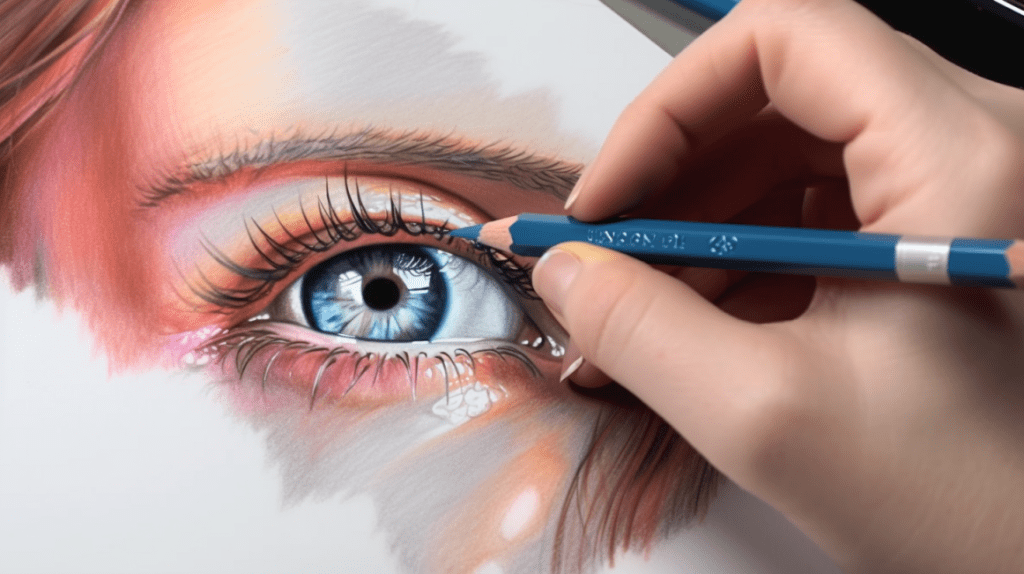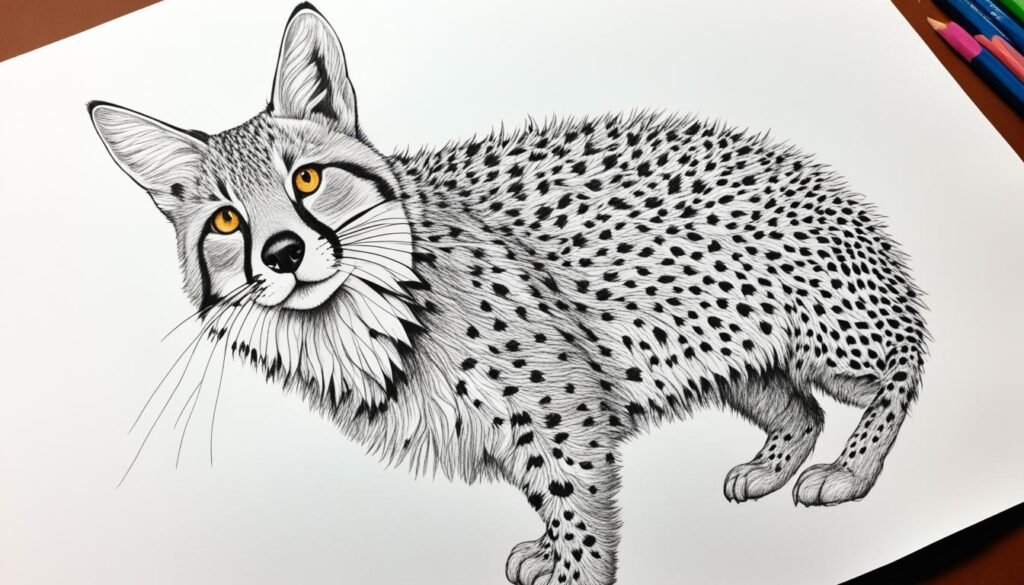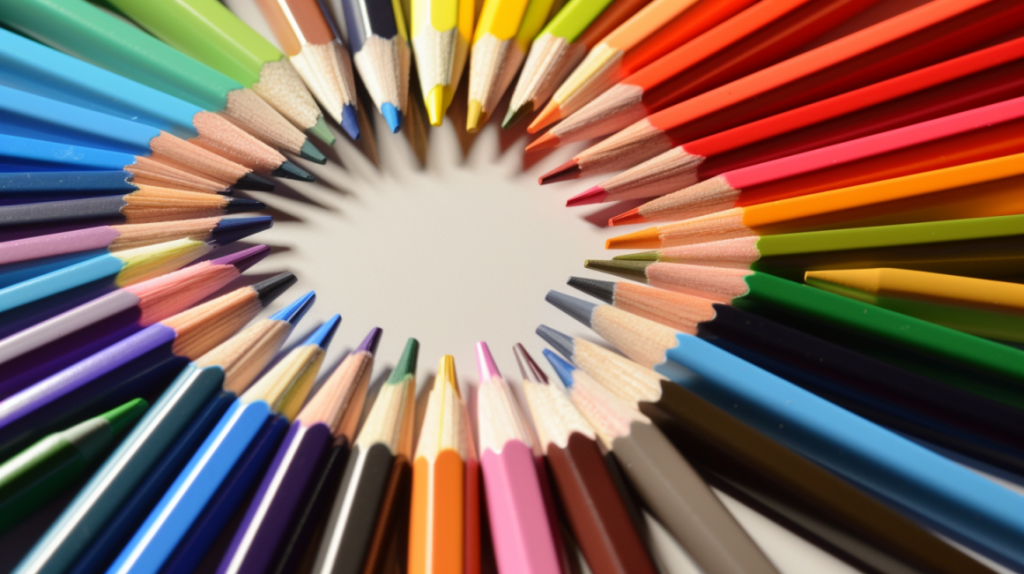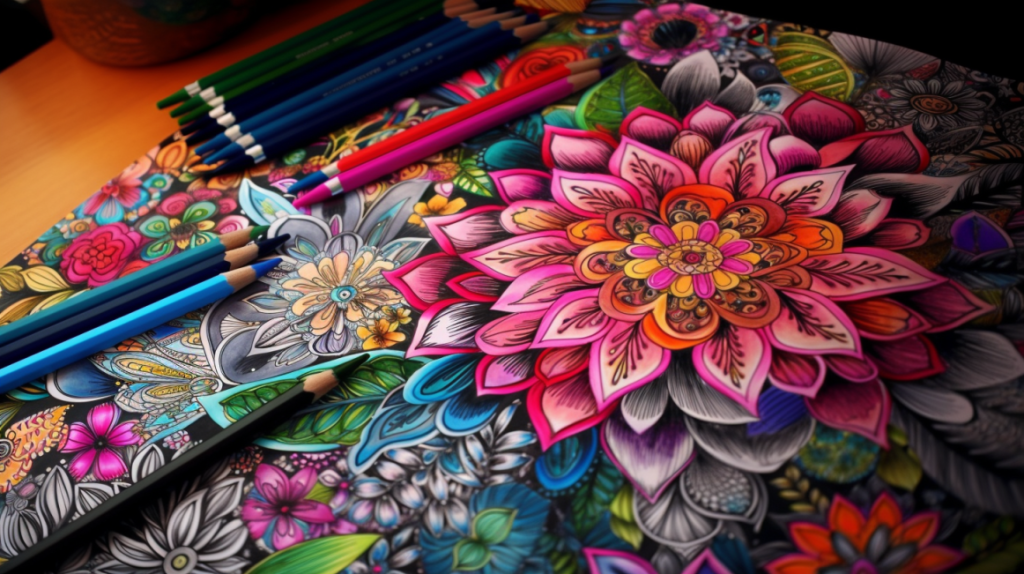In recent years, coloring has become a recognized relaxation tool. It’s now used in therapy to help with mental health.
Exploring using coloring books in therapy shows it’s more than a childhood activity. It’s a way to find well-being. It invites a meditative state through simple motions, similar to mindfulness and stress relief.

Adult coloring books offer structured art activities. They might be just what your mind needs to declutter and destress.
Coloring as a relaxation tool has evolved. It’s now a therapeutic coloring method used by professionals. It helps people focus on patterns and colors instead of life’s anxieties.
These books come in various designs, each aiming to foster calm. From paisley to nature themes, there’s something for everyone.
The beauty of coloring lies in its simplicity. It offers calming effects at a low cost. For many, art therapy coloring is a self-selected cocoon. It provides a break from daily chaos and helps people reconnect with themselves through creativity and color.
Key Takeaways
- Adult coloring books serve as an affordable, therapeutic tool to help alleviate stress and promote mental well-being.
- The structure and intricacy of coloring designs can invoke a meditative state akin to traditional relaxation practices.
- Mindful engagement in coloring can provide a therapeutic distraction from negative emotions and enhance focus.
- In therapy, coloring activities not only build rapport but also offer insights into a client’s emotional state and creativity.
- Coloring can pave the way for improved self-esteem and skills such as patience and persistence, especially in children and adolescents.
- Structured coloring patterns like mandalas may be particularly effective in reducing anxiety, promoting perseverance, and nurturing creativity.
- The act of coloring can evoke a sense of achievement and pride, enriching one’s self-concept and artistic identity.
The Rise of Adult Coloring Books in Therapeutic Settings
Adult coloring books are becoming popular in therapy. They offer benefits of coloring therapy and help with stress and anxiety. These books are more than just for fun; they have a deep psychological purpose.
Studies show that coloring can lower anxiety and stress. For example, coloring mandalas can be very soothing. A 2012 study found that 20 minutes of coloring can reduce stress levels.
Coloring also builds mental strength. It can put you in a meditative state, like mindfulness practices. This helps with stress and improves mental health over time.
Coloring also improves focus and concentration. It’s like a workout for your brain. It can help shift your thoughts to a more positive place.
| Stress Influence | Coloring Activity | Effect Observed |
|---|---|---|
| High Anxiety | Mandala Coloring | Reduced Anxiety and Improved Mood |
| Emotional Distress (Cancer Patients) | Mindfulness Art Therapy | Significant decrease of Distress |
| General Stress | Short sessions of Coloring | Lowered Stress Levels |
Adult coloring books are now a part of therapy. They are not just for fun. They are a real form of art therapy.
Coloring books are becoming a big part of therapy. They offer a mix of creativity and structure. This makes them a unique tool for therapy.
Understanding the Brain Benefits of Coloring
Coloring used to be just for kids, but now it’s a big deal for adults too. Adult coloring books are everywhere. But what happens in your brain when you color?
Activation of Cerebral Hemispheres
Coloring is like a brain workout. It makes different parts of your brain work together. When you pick colors, your creative right brain gets excited.
Your logical left brain kicks in when you color inside the lines. This is key to coloring therapy.
Coloring for Improved Focus and Logic
Coloring is more than just staying inside the lines. It helps you focus, think logically, and make decisions. Studies show that coloring can improve these skills.
It requires you to pay close attention to details. This helps your brain stay focused and calm, even when life gets busy.
Adult coloring books are back in style for good reasons. They help with stress and improve your mental skills. Whether you’re coloring mandalas or choosing colors for calmness, the benefits last long.
So, when you color, you’re not just killing time. You’re making your brain healthier and finding peace. Grab those crayons or markers and enjoy some coloring. It’s a fun way to boost your creativity and brain power.
Meditative States Induced by Coloring
Adult coloring books have become very popular. They’re not just a fun trip back to childhood. They also offer a deep therapeutic benefit, especially in creating meditative states. Studies show that coloring can make you focus on the present moment and calm your mind.
Coloring can be a great way to relax and reduce anxiety. It requires focus, similar to meditation. This focus helps quiet your mind, reducing stress and negative thoughts.
Coloring can improve your mental clarity and mindfulness. It’s not just a fun activity. Studies support that using coloring books in therapy can reduce stress, improve mood, and increase mindfulness.
- Coloring can improve brain function by activating different parts of the brain’s cerebral hemispheres.
- Regular coloring sessions help in managing anxiety symptoms, contributing significantly to relaxation.
- The ritualistic nature of coloring before bed has shown to lead to better sleep quality, compared to using electronic devices that emit blue light.
The following table illustrates the scientific findings on how coloring can stimulate a meditative state and its associated benefits of coloring therapy based on comparative studies:
| Study | Focus | Findings | Year |
|---|---|---|---|
| Curry & Kasser (2005) | Anxiety Levels | Significant decrease in anxiety coloring mandalas versus free-drawing | 2005 |
| van der Vennet & Serice (2012) | Mandala Coloring | Reduced anxiety levels in mandala group versus plaid and free-drawing | 2012 |
| Henderson et al. (2007) | Long-term effects on PTSD | Significant decrease in PTSD symptoms post 1-month of coloring | 2007 |
This compilation shows how effective coloring can be as a meditative and therapeutic practice. It’s why using coloring books in therapy is becoming more popular. It’s a simple way to manage stress, reduce anxiety, or find a moment of peace.
Coloring Techniques as a Tool for Stress Relief
Exploring coloring for stress relief shows us how detailed designs and special coloring techniques help. These methods not only help us relax but also improve our mental health. This makes coloring as a relaxation tool very valuable in therapy.
Improving Sleep Quality
Therapeutic coloring can also help improve sleep. Switching from screens to coloring books at night reduces blue light. This helps your body make more melatonin, leading to better sleep.
With therapeutic coloring, you can create a calm bedtime routine. This routine helps you sleep better.
The Efficacy of Intricate Designs
Intricate designs, like mandalas, are great for coloring for stress relief. Research shows they lower anxiety by focusing the mind. This makes coloring like meditation, clearing your mind and relaxing you.
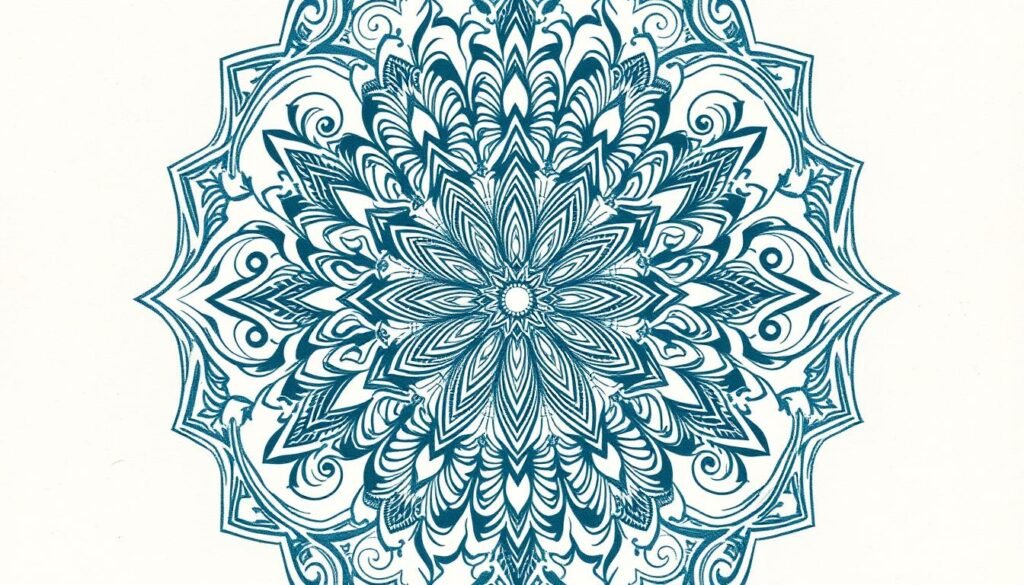
- Choose coloring materials that feel right for you, whether they be crayons, markers, or colored pencils.
- Select designs that personally appeal to you, as this increases the therapeutic effect.
- Set aside a regular, dedicated time for coloring, creating a consistent relaxing ritual.
Also, coloring with others can be beneficial. Joining groups or communities to share experiences and techniques can enhance the therapeutic coloring benefits. This adds to the joy of creating together.
As coloring as a relaxation tool becomes more recognized, it’s becoming a key part of our lives. It helps us deal with stress and improve our mental health in our busy world.
The Psychology Behind Coloring as a Relaxation Tool
Finding peace in our busy lives can be hard. Luckily, coloring book therapy techniques help a lot. Coloring, once a fun childhood activity, now helps adults relax. It’s not just about going back to happy times. It also helps your mind relax and feel better.
Coloring lets you forget about worries and focus on the moment. It’s not just about staying in the lines. It’s about calming your mind and being fully present. This makes coloring a peaceful place for your mind to rest.
| Aspect | Benefit |
|---|---|
| Reduction in Anxiety | Facilitates a meditative state reducing rumination and promoting calmness. |
| Engagement of Brain | Stimulates brain areas linked to creativity and relaxation. |
| Improvement in Mood | Stimulates endorphin release boosting overall well-being. |
| Stress Management | Decreases cortisol levels, enhancing emotional stability. |
Mental health coloring activities help you enter a ‘flow’ state. This is when you’re completely in the moment, forgetting everything else. This state is not only calming but also makes you feel more fulfilled. Adding coloring book therapy techniques to your life can fight stress and anxiety, leading to a natural calm.
In short, coloring is more than just drawing. It’s a way to improve your mind and heart. By making coloring a regular part of your life, you get instant calm and long-term emotional strength.
Using Coloring Books in Therapy
Recent studies show that coloring books can greatly help in therapy. They help people relax and offer many benefits. These books are especially popular among adults and help them find mental peace.
Donna Betts, president of the American Art Therapy Association, notes a big increase in interest in coloring books for therapy. Many adult coloring books are now best-sellers on Amazon. This shows how much they are valued as a tool for therapy.
| Profile | Experience with Coloring | Impact Noticed |
|---|---|---|
| Paula Meng, 52, St Petersburg, FL | Colors several hours a day | Alleviates anxiety, depression, and back pain |
| Cari Schofield, 38, Stockbridge, GA | Returned to drawing through coloring books | Found it therapeutic for managing epilepsy |
| Study Findings on Therapeutic Coloring | ||
| Mandalas vs. Plaid Prints (Curry & Kasser) | Mandalas | More effective in anxiety reduction |
| Guided Coloring (Mantzios and Giannou) | Mandala coloring | Reduced anxiety more than unguided group |
| Mandalas Effect (International Islamic University Islamabad Study) | 30-minute coloring session | Significant decrease in state and trait anxiety |
Studies prove that coloring books are more than just fun. They help reduce anxiety, especially with mandalas. A study from the University of Otago found that coloring puzzles can help with anxiety and depression.
While coloring books are not a cure-all, they are a great starting point for therapy. They make it easier for people to try art therapy. This can help them deal with deeper emotional issues.
Physical Health Benefits From Stress Reduction
Coloring is more than just a hobby. It offers deep stress relief and health benefits. This simple activity can calm your mind and improve your physical health.
Coloring is a way to reduce stress, which is good for your body. It can lower blood pressure and help you sleep better. This makes coloring a great way to improve your health.
- Studies show that coloring can significantly lower the heart rates and stabilize the brain’s activity, leading to a profound state of calm.
- In recent research involving adult participants, the activity not only reduced immediate feelings of anxiety but also contributed to long-term advantages including better sleep patterns and lower depression levels.
- Coloring activities are recognized for evoking a sense of nostalgia, providing emotional relief which contributes to overall stress reduction.
A 2020 study found that adults felt less anxious after 20 minutes of mandala coloring. Another study showed that coloring with therapy improved anxiety and positive feelings.
Coloring is simple yet effective for stress relief. It’s great for anyone, whether you’re busy or retired. Adding coloring to your routine can refresh your mind and improve your health.
Appreciating the Artistic Side: Creativity and Self-expression
Art therapy coloring is more than just coloring inside the lines. It’s a deep dive into self-expression and creativity. Choosing colors in coloring as a relaxation tool goes beyond just picking colors. It’s connected to how you feel and what you’ve experienced. It can help you find peace and discover more about yourself.

Exploring art therapy coloring can lead you to colors and patterns that speak to you. This connection is powerful. It lets you explore your emotions without needing to say a word.
Choosing Colors and Forming Associations
When you pick a coloring book, your color choices say a lot. They’re a way to express feelings and thoughts without words. This form of art therapy coloring can bring comfort and clarity. It helps uncover hidden emotions and starts a conversation with yourself.
Coloring as a Gateway to Art Therapy
For many, coloring as a relaxation tool is just the start. Regular coloring can lead to exploring more art forms. This can include painting, sculpture, or mixed media. It helps you discover more about yourself and your creativity.
Whether you’re new to art or have been doing it for years, coloring can improve your mental and emotional health. This journey through coloring and into art therapy can change your life. It offers a special way to gain insight and heal.
Combating Anxiety with Coloring Book Therapy Techniques
More people are finding relief from stress with coloring book therapy techniques. This method of therapeutic coloring helps people relax and focus on the moment. It’s a simple way to improve mental health.
Coloring as a Mindful Practice
Studies show that coloring books help with mindfulness. They require focus, similar to meditation. People who colored reported feeling calmer and more mindful.
Addressing Misconceptions in Therapeutic Coloring
Some think coloring books are just for fun. But they can help with deeper issues when used right. Not all coloring books are the same, and some images don’t help with anxiety.
Research shows that well-designed coloring books are very effective. They have complex patterns that keep you focused. Since 2014, adult coloring books have become more popular, showing their value in mental health.
Seeing coloring book therapy techniques as a real tool against anxiety is key. Using them in therapy or for relaxation can help. As more people use coloring for mental health, its benefits grow.
Bridging Professional Art Therapy and Personal Self-care
The lines between art therapy coloring and personal self-care, like coloring for stress relief, are getting fuzzy. It’s key to know their unique benefits and roles. While therapeutic coloring in adult coloring books can be calming, it’s not the same as the deep therapy a professional art therapist offers.
Art therapy is more than just coloring. It’s about exploring deep personal issues and emotions through art, with a trained therapist’s help. This process helps people express feelings that are hard to put into words. It also boosts thinking and motor skills, builds self-awareness, and strengthens emotional strength.
| Benefits of Professional Art Therapy | Benefits of Coloring for Stress Relief |
|---|---|
| Addresses deep-rooted emotional and psychological issues | Provides immediate stress reduction and relaxation |
| Improves cognitive and sensorimotor functions | Improves focus and mindfulness |
| Enhances self-esteem and self-awareness | Accessible and can be done anywhere with minimal materials |
| Facilitated by professionals with specialized training | Does not require professional supervision |
Despite their differences, adult coloring books have sparked a big interest in art therapy coloring. This has made art therapy more understandable and accessible to everyone.

Therapeutic coloring can be a starting point for exploring creativity and self-care. But it’s different from professional art therapy, which aims for specific goals. Art therapy can help reduce anxiety and depression. It also helps grow emotionally and improve social skills through targeted therapy.
Starting with coloring for stress relief can lead to discovering the powerful effects of art with professional help. This mix of professional art therapy and personal self-care offers a complete approach to mental health. It shows that everyone’s healing journey is unique and full of creative possibilities.
Mental Health Coloring Activities and Their Limitations
Coloring books can help with mental health, but knowing the difference between therapeutic and recreational coloring is key. It’s important to see the benefits of coloring therapy. But, these benefits change when a trained therapist guides you.
Therapeutic Versus Recreational Coloring
Therapeutic coloring is used in art therapy to tackle mental health issues. It’s designed to help with specific problems. Recreational coloring, however, is just for fun. It’s done without the help of a mental health expert.
The Role of the Therapist in Guided Art Therapy
A therapist is vital in guided art therapy. They use coloring to understand a person’s mind and help them talk about feelings. This helps uncover deep issues and guides towards healing.
Here’s a glance at the study highlighting the benefits of coloring therapy:
| Statistic | Data |
|---|---|
| Annual prevalence of GAD | 1.9%–5.1% |
| Lifetime prevalence of GAD | 4.1%–6.6% |
| Comorbidity rate of GAD with depression | 45.7%–70.0% |
| Effectiveness of coloring therapy | Significant reduction in depression and anxiety |
| Improvement in negative and positive emotions | Statistically significant improvement noted in experimental vs control group |
The data shows how important coloring books are in therapy. They’re not just for fun. They’re a key part of a treatment plan. Coloring can really help with anxiety and depression.
When thinking about coloring for mental health, remember the difference. It’s not just for fun. It’s a serious part of therapy.
Conclusion
Therapeutic coloring and art therapy coloring are simple yet powerful tools for mental relaxation. They can unlock benefits that go beyond the page. These activities can improve cognitive function and physical health.
The American College Health Association found that many students struggle with anxiety. This affects their school work. Coloring can help by boosting serotonin levels and improving well-being.
Coloring is enjoyable and can be a self-care activity. However, it’s different from professional art therapy. Art therapy uses a clinician’s expertise to help. But coloring can still help manage stress and find peace.
Studies show that coloring can improve mood and cognitive skills. It can also help people interact better with others. This makes coloring a great way to start positive mental health habits.
The colors and patterns you choose are more than just fun. They’re a way to practice mindfulness and take care of your well-being. Coloring has been shown to help with pain, Alzheimer’s, and motor skills.
While more research is needed, the short-term benefits are clear. Coloring can reduce stress and help you relax. It’s a useful tool for finding calm in a busy world.
FAQ
How are coloring books used in therapy?
What are the mental health benefits of coloring activities?
Can coloring help with relaxation?
What are the therapeutic benefits of coloring for adults?
How does coloring activate the cerebral hemispheres?
What is the connection between coloring and improved focus and logic?
How does coloring induce a meditative state?
How can coloring improve sleep quality?
Do intricate designs in coloring books offer more benefits than simpler ones?
How does coloring influence psychology and stress management?
What are the physical health benefits of reducing stress through coloring?
How does coloring foster creativity and self-expression?
Can coloring be considered a form of mindful practice?
How do therapeutic coloring activities differ from recreational coloring?
What role does an art therapist play in guided art therapy as compared to coloring books?
Source Links
- Is There a Place For Coloring Books in Art Therapy? – Creativity in Therapy
- Does Coloring Count As Therapy?
- Color the World- The Therapeutic Benefits of Adult Coloring Books and Simple Art Therapies – Living at Life University
- The Therapeutic Science Of Adult Coloring Books: How This Childhood Pastime Helps Adults Relieve Stress
- 9 Reasons to Try Coloring for Adults
- Why adult coloring books are good for you | CNN
- 3 Reasons Adult Coloring Can Actually Relax Your Brain
- Adult Coloring Books: 7 Benefits of Coloring
- When Did Coloring Books Become Mindful? Exploring the Effectiveness of a Novel Method of Mindfulness-Guided Instructions for Coloring Books to Increase Mindfulness and Decrease Anxiety
- Coloring is not just for kids! | CHE Behavioral Health Services
- 3 Reasons Adult Coloring Can Actually Relax Your Brain
- The Therapeutic Benefits of Coloring Books for Adults
- How Coloring Books are Effective Stress Relief Tools – Alaska Sleep Clinic
- Therapeutic Benefits of Adult Coloring Books
- 10 Benefits of Adult Coloring Books on Stress & Anxiety
- 10 Benefits of Coloring Pages for Kids’ Psychology and Development
- Color Me Cautious: Don’t Mistake Adult Coloring Books for Art Therapy | Columbian College of Arts & Sciences | The George Washington University
- Coloring books for adults: we asked therapists for their opinions
- Are Adult Coloring Books Actually Helpful?
- 8 Therapeutic Benefits of Coloring in Adult Coloring Books and Apps
- The effects of coloring therapy on patients with generalized anxiety disorder
- Let The Artistic Side Flow
- Building Creative Confidence in Art Therapy – Creativity in Therapy
- Feeling Anxious? Scientists Recommend Coloring
- How Coloring Books Help Anxious Children – and Adults
- Art Therapy vs. Art in Therapy: What You Need to Know — HeARTS for Hope: Art Therapy and Trauma Conscious Embodied Healing in Greenville SC
- Art therapy: Benefits and treatment options
- Art making and expressive art therapy in adult health and nursing care: A scoping review
- The Effectiveness of Structured Coloring Activities for Anxiety Reduction
- How Does Coloring Affect Your Mental Health?
- HOW DOES COLORING INFLUENCE MOOD, STRESS, AND MINDFULNESS?
- 11 Key Ways That Memory Care Residents Can Benefit From Coloring – IntegraCare

